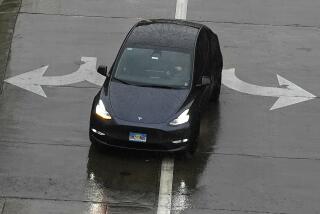Car owners are waiting longer to replace their vehicles
- Share via
So much for the long-held notion that Americans purchase a new car and flip it every three or four years.
People who buy new cars are holding on to their vehicles for a record amount of time, an average of almost six years, according to the automotive research firm R.L. Polk & Co.
The recent recession has pushed people to hold on to their cars and pay off their loans. In the process, they discovered that their vehicles were more reliable than they might have expected, said Mark Seng, a Polk analyst.
Automakers are looking at the trend and believe that it’s one reason it will take some time for auto sales to return to the pre-recession levels as more people learn to live with older cars.
It coincides with what Hyundai Motor America Chief Executive John Krafcik says is “a fundamental change in the way Americans think about their automobiles.”
An automobile has dropped in importance in the hierarchy of social status since the recession, he said, making “the need to change your car to show who you are less important.”
Geoff Moore, a Los Angeles screenwriter, agrees.
“We drive our cars until the wheels fall off,” he said. “It seems wasteful to keep flipping cars.”
Moore and his wife, Nicki, just replaced a 1995 Honda Civic with 140,000 miles with a new Subaru Forester, which they intend to keep for at least a decade. They also own a 2005 Volvo station wagon.
Polk said the typical buyer of a new car keeps the vehicle for 71.4 months, an increase of almost 18 months since 2006. Because its review of car registrations includes leases, people who buy their cars outright are probably holding on to the vehicles even longer, Seng said.
Improving auto quality is pushing the trend, said David Champion, senior director of Consumer Reports’ automotive test center.
In the past, people sold their cars well before they reached 100,000 miles, which was about the mileage at which drivers thought the vehicles would be worn out.
“You would sell the car at 60,000 miles to get some residual value out of it. But nowadays 100,000 miles is only halfway through the life of the car,” Champion said.
Automakers have also lengthened their warranties. Most new cars come with a three-year or 36,000-mile warranty. Hyundai includes a five-year or 60,000-mile warranty and goes to 10 years or 100,000 miles on the powertrain.
John Maigler, a retired United Airlines mechanic and manager from Des Plaines, Ill., purchased a Kia Soul in 2010 because he liked the 10-year or 100,000-mile warranty on the powertrain.
“I keep my cars a long time. I am cheap,” Maigler said.
The trend isn’t expected to reverse, even if the economy takes off and people feel secure enough financially to buy new vehicles.
“Longer ownership periods are with us to stay,” Krafcik said. “Longer loan terms tend to drive longer ownership periods as people pay down their loans. Cars are better and last longer. And the brands that have longer warranties like Hyundai are gaining market share.”
More to Read
Inside the business of entertainment
The Wide Shot brings you news, analysis and insights on everything from streaming wars to production — and what it all means for the future.
You may occasionally receive promotional content from the Los Angeles Times.











